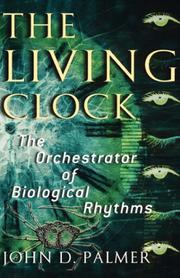| Listing 1 - 10 of 17 | << page >> |
Sort by
|
Book
ISBN: 0471857629 Year: 1988 Publisher: New York (N.Y.): Wiley
Abstract | Keywords | Export | Availability | Bookmark
 Loading...
Loading...Choose an application
- Reference Manager
- EndNote
- RefWorks (Direct export to RefWorks)
Chronobiology --- Chronobiologie --- Biological time --- Biology --- Time

ISBN: 128053138X 9786610531387 0198032757 1602566682 9780198032755 9780195143409 019514340X 9781280531385 0195184580 9780195184587 0197701507 0190286644 Year: 2023 Publisher: New York ; Oxford University Press,
Abstract | Keywords | Export | Availability | Bookmark
 Loading...
Loading...Choose an application
- Reference Manager
- EndNote
- RefWorks (Direct export to RefWorks)
An introduction to a basic property of life, one mostly unknown to science and the public until the latter half of the last century: humans, plants, and animals have within their bodies a kind of clock that synchronizes much of what they do with the time of day, the seasons or the tides.
Chronobiology --- Biological time --- Biology --- Time --- Biological rhythms. --- Jet lag.
Book
ISBN: 9781629489766 162948976X 9781631170270 1631170279 Year: 2014 Publisher: New York : Nova Biomedical,
Abstract | Keywords | Export | Availability | Bookmark
 Loading...
Loading...Choose an application
- Reference Manager
- EndNote
- RefWorks (Direct export to RefWorks)
Cardiovascular system --- Chronobiology. --- Biological time --- Biology --- Time --- Cardiovascular diseases --- Diseases.
Book
ISBN: 1789849012 1789849004 Year: 2019 Publisher: London : IntechOpen,
Abstract | Keywords | Export | Availability | Bookmark
 Loading...
Loading...Choose an application
- Reference Manager
- EndNote
- RefWorks (Direct export to RefWorks)
Neurosciences. --- Chronobiology. --- Biological time --- Biology --- Time --- Neural sciences --- Neurological sciences --- Neuroscience --- Medical sciences --- Nervous system
Book
ISBN: 2225844127 2225844127 9782225844126 Year: 1994 Publisher: Paris Masson
Abstract | Keywords | Export | Availability | Bookmark
 Loading...
Loading...Choose an application
- Reference Manager
- EndNote
- RefWorks (Direct export to RefWorks)
Biological time --- Chronobiologie --- Disorders of sleep --- Dormir --- Rusten --- Slaapstoornissen --- Sleep --- Sleep disorders --- Sleeping --- Slumber --- Sommeil [Troubles du ] --- Stoornissen [Slaap] --- Troubles du sommeil --- Chronobiology
Book
ISBN: 0674069692 0674065859 0674065484 9780674065482 9780674065857 9780674069695 Year: 2012 Publisher: Cambridge, MA
Abstract | Keywords | Export | Availability | Bookmark
 Loading...
Loading...Choose an application
- Reference Manager
- EndNote
- RefWorks (Direct export to RefWorks)
Early birds and night owls are born, not made. Sleep patterns may be the most obvious manifestation of the highly individualized biological clocks we inherit, but these clocks also regulate bodily functions from digestion to hormone levels to cognition. Living at odds with our internal timepieces, Till Roenneberg shows, can make us chronically sleep deprived and more likely to smoke, gain weight, feel depressed, fall ill, and fail geometry. By understanding and respecting our internal time, we can live better.Internal Time combines storytelling with accessible science tutorials to explain how our internal clocks work-for example, why morning classes are so unpopular and why "lazy" adolescents are wise to avoid them. We learn why the constant twilight of our largely indoor lives makes us dependent on alarm clocks and tired, and why social demands and work schedules lead to a social jet lag that compromises our daily functioning.Many of the factors that make us early or late "chronotypes" are beyond our control, but that doesn't make us powerless. Roenneberg recommends that the best way to sync our internal time with our external environment and feel better is to get more sunlight. Such simple steps as cycling to work and eating breakfast outside may be the tickets to a good night's sleep, better overall health, and less grouchiness in the morning.
Chronobiology. --- Biological rhythms. --- Biological clocks --- Biology --- Biorhythms --- Endogenous rhythms --- Living clocks --- Rhythms, Biological --- Chronobiology --- Cycles --- Pacemaker cells --- Biological time --- Time --- Periodicity
Book
ISBN: 9780736082747 0736082743 Year: 2011 Publisher: Champaign, IL Human Kinetics
Abstract | Keywords | Export | Availability | Bookmark
 Loading...
Loading...Choose an application
- Reference Manager
- EndNote
- RefWorks (Direct export to RefWorks)
In this exceptionally readable exploration of athletic achievement, the author draws practical conclusions from science and experience to describe how various aspects of time affect sport performance. Readers can investigate challenging questions such as whether athletes consciously control sport performance, how young athletes can be safely nurtured to greatness, and what the optimal time of day is for training. This book takes you on a wide-ranging journey into the complexity and beauty of the human body in motion. It will forever change the way you watch and participate in sport as you come to realize it's all in the timing. -- from Back Cover.
Athletic Performance --- Chronobiology Phenomena --- Sports --- Chronobiology. --- Chronobiologie --- physiology. --- Physiological aspects. --- Aspect physiologique --- Biological time --- Biology --- Time --- Athletics --- Sports physiology --- Sports sciences --- Physiological aspects --- 612:796 --- 612:796 Fysiologie van de sport --- Fysiologie van de sport --- Chronobiology --- physiology
Book
ISBN: 1402047010 Year: 2006 Publisher: Dordrecht : Springer Netherlands : Imprint: Springer,
Abstract | Keywords | Export | Availability | Bookmark
 Loading...
Loading...Choose an application
- Reference Manager
- EndNote
- RefWorks (Direct export to RefWorks)
Biological rhythms are a fundamental property of all life and encompass a wide range of frequencies, from seconds to a century or more. Introducing Biological Rhythms is a primer that serves to introduce individuals to the area of biological rhythms. It describes the major characteristics and discusses the implications and applications of these rhythms, while citing scientific results and references. Also, the primer includes essays that provide in-depth historic and other background information for those interested in more specific topics or concepts. Introducing Biological Rhythms covers a basic cross-section of the field of chronobiology clearly enough so that it can be understood by a novice, or an undergraduate student, but it is also sufficiently technical and detailed for the scientist. "[Koukkari and Sothern] deal with the basic information at the beginning of the book and with applications at the end. The Essays attached to each chapter are very useful digressions and the ‘Take Home Message’ a good idea." - Dr. B. Millet, Université de Franche-Comté (Besançon, France).
Biological rhythms. --- Chronobiology. --- Biological time --- Biology --- Time --- Biological clocks --- Biorhythms --- Endogenous rhythms --- Living clocks --- Rhythms, Biological --- Chronobiology --- Cycles --- Pacemaker cells --- Periodicity --- Life sciences. --- Botany. --- Animal physiology. --- Biodiversity. --- Life Sciences, general. --- Plant Sciences. --- Animal Physiology. --- Animal physiology --- Animals --- Anatomy --- Botanical science --- Phytobiology --- Phytography --- Phytology --- Plant biology --- Plant science --- Natural history --- Plants --- Biosciences --- Sciences, Life --- Science --- Biological diversification --- Biological diversity --- Biotic diversity --- Diversification, Biological --- Diversity, Biological --- Biocomplexity --- Ecological heterogeneity --- Numbers of species --- Physiology --- Plant science. --- Floristic botany

ISBN: 3540615253 3642082653 3662093553 Year: 1997 Volume: 125 Publisher: Berlin ; Heidelberg ; New York Springer
Abstract | Keywords | Export | Availability | Bookmark
 Loading...
Loading...Choose an application
- Reference Manager
- EndNote
- RefWorks (Direct export to RefWorks)
Measured by any criteria, research in chronobiology in general and chronopharmacology in particular has expanded rapidly in recent years. This expansion has been paralleled by an increasing recognition by those outside the field of the relevance and significance of recent developments in chronobiology. Advances in two areas have been chiefly responsible. First, application of the full range of modern techniques in behavioral, neurochemical, and molecular biology have greatly improved our understanding of basic clock mechanisms. In several species the genetic basis of the circadian clock is being progressively delineated. A complete picture of the neurochemical and neuroanatomical structure of the mammalian clock is emerging and the complex pattern of control mechanisms involving endogenous clock mechan isms and photic and nonphotic zeitgebers is being built up as a result of behavioral studies. Secondly, in parallel with these exciting developments in basic science, clinical applications are being convincingly demonstrated in the general fields of pharmacology and medicine as well as in specific areas, e.g., jet lag, shiftwork maladaption syndrome, blindness, and cardiovascular system. It is therefore an opportune time to review progress in the field of chronopharmacology and to introduce some of the exciting developments and prospects to a readership beyond the confines of the chronobiological cognoscenti. This volume is therefore aimed primarily at the pharmacologist - whether basic, applied, or clinical-who is not a specialist in chronobiology.
Biological time --- Chronobiologie --- Chronobiology --- Chronofarmacologie --- Chronopharmacologie --- Chronopharmacology --- Farmacologie [Chrono] --- Pharmacologie [Chrono] --- Chronobiology. --- Chronopharmacology. --- Circadian rhythm --- Drug Therapy. --- drug effects. --- physiology. --- Drug effects. --- Physiology. --- Pharmacology. --- Human physiology. --- Biochemistry. --- Neurosciences. --- Animal physiology. --- Pharmacology/Toxicology. --- Human Physiology. --- Biochemistry, general. --- Animal Physiology. --- Animal physiology --- Animals --- Biology --- Anatomy --- Neural sciences --- Neurological sciences --- Neuroscience --- Medical sciences --- Nervous system --- Biological chemistry --- Chemical composition of organisms --- Organisms --- Physiological chemistry --- Chemistry --- Human biology --- Physiology --- Human body --- Drug effects --- Medical pharmacology --- Chemicals --- Chemotherapy --- Drugs --- Pharmacy --- Composition --- Physiological effect --- Time --- Pharmacology
Book
ISBN: 9780521760539 0521760534 9780511803567 9780511676680 0511676689 9780511681172 0511681178 0511803567 1107207851 0511739583 1282525859 9786612525858 0511677944 0511683154 051167919X Year: 2010 Publisher: Cambridge Cambridge University Press
Abstract | Keywords | Export | Availability | Bookmark
 Loading...
Loading...Choose an application
- Reference Manager
- EndNote
- RefWorks (Direct export to RefWorks)
Do intertidal organisms simply respond to the rise and fall of tides, or do they possess biological timing and navigation mechanisms that allow them to anticipate when conditions are most favourable? How are the patterns of growth, development and reproduction of some marine plants and animals related to changes in day-length or to phases of the moon? The author describes how marine organisms, from single cells to vertebrates, on sea shores, in estuaries and in the open ocean, have evolved inbuilt biological clockwork and synchronisation mechanisms which control rhythmic processes and navigational behaviour, permitting successful exploitation of highly variable and often hostile environments. Adopting a hypothesis-testing and experimental approach, the book is intended for undergraduate and postgraduate students of marine biology, marine ecology, animal behaviour, oceanography and other biological sciences and also as an introduction for researchers, including physiologists, biochemists and molecular biologists entering the field of chronobiology.
Marine biology --- Chronobiology --- Marine animals --- Biologie marine --- Chronobiologie --- Life cycles --- Marine biology. --- Chronobiology. --- Life cycles. --- Marine fauna --- Ocean animals --- Sea animals --- Aquatic animals --- Marine organisms --- Biological time --- Biology --- Time --- Biological oceanography --- Ocean biology --- Oceanic biology --- Sea biology --- Aquatic biology --- Marine sciences --- Intertidal organisms --- Intertidal animals --- Biological rhythms. --- Physiology. --- Biological clocks --- Biorhythms --- Endogenous rhythms --- Living clocks --- Rhythms, Biological --- Cycles --- Pacemaker cells --- Intertidal fauna --- Seashore animals --- Coastal organisms --- Aquatic organisms --- Periodicity
| Listing 1 - 10 of 17 | << page >> |
Sort by
|

 Search
Search Feedback
Feedback About UniCat
About UniCat  Help
Help News
News